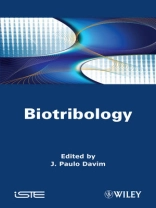Tribology is the ‘science and technology of interacting
surfaces in relative motion’ and encompasses the study of
friction, wear and lubrication. By extension biotribology is
usually defined as the tribological phenomena occurring in either
the human body or in animals. Therefore, it is possible to consider
tribological processes that may occur after implantation of an
artificial device in the human body and the tribological processes
naturally occurring in or on the tissues and organ of animals.
Animals, including humans, possess a wide variety of sliding and
frictional interfaces.
The authors aim to provide some advances in research in
biotribology. They cover several aspects of biotribology such as
tribology of synovial joints and artificial replacements; wear of
screws and plates in bone fractures repair; wear of denture and
restorative materials; friction of the skin and comfort of
clothing; wear of replacement heart valves; tribology of contact
lenses and ocular tribology; biotribology on the microscale and
nanoscale levels, etc.
This book can be used as a research text for final undergraduate
engineering courses (for example, materials, biomedical, etc.) or
for those studying the subject of biotribology at the postgraduate
level. It can also serve as a useful reference for academics,
biomechanical researchers, biologists, chemists, physicists,
biomedicals and materials engineers, and other professionals in
related engineering, medicine and biomedical industries.
विषयसूची
Chapter 1. Biotribology of Total Hip Replacement: the Metal-on-Metal Articulation 1
J. Philippe KRETZER
1.1. Introduction 1
1.2. Historical development of metal-on-metal bearings in totalhip replacements 3
1.3. Design and materials 4
1.3.1. Implant geometry 4
1.3.2. Manufacturing methods and metallurgy 5
1.4. Tribology of metal-on-metal bearings in total hipreplacement 10
1.4.1. Wear and types of friction 10
1.4.2. EHL theory of lubrication 12
1.4.3. Friction in physiological joints 17
1.4.4. Friction in artificial joints 17
1.5. Wear testing 18
1.5.1. Simulation in hip simulators 18
1.5.2. Wear determination 21
1.5.3. Wear properties 23
1.5.4. Results of wear tests 24
1.5.5. Summary of results from simulator studies 30
1.5.6. Wear mode 31
1.6. Clinical relevance of metal wear particles and metal ions33
1.7. Conclusion 35
1.8. Acknowledgments 36
1.9. Bibliography 36
Chapter 2. Experimental Wear Studies of Total Joint Replacements51
Claire BROCKETT and John FISHER
2.1. Introduction 51
2.2. Methods for assessing tribology in total joint replacement52
2.2.1. Lubrication 53
2.2.2. Friction 54
2.2.3. Wear 57
2.3. Effects of material and design on the tribology of totaljoint replacements 62
2.3.1. Total hip and resurfacing replacements 62
2.3.2. Total knee replacement 73
2.4. Conclusion 78
2.5. Bibliography 79
Chapter 3. Influence of Temperature on Creep and Deformationin UHMWPE under Tribological Loading in Artificial Joints87
Mathias Christian GALETZ and Uwe GLATZEL
3.1. Temperature in artificial joints 87
3.1.1. Artificial knee joints 87
3.1.2. Why does temperature affect the performance of artificialjoints? 89
3.1.3. Mathematical approaches to estimate the contacttemperature during friction 91
3.1.4. Temperature rise during cyclic tribological sliding95
3.2. Temperature influence on creep and fatigue mechanisms of UHMWPE under tribological loading 102
3.2.1. Temperature dependence of the yield strength of UHMWPE102
3.2.2. Temperature dependence of the creep strength of UHMWPE107
3.2.3. Temperature-dependent deformation under tribologicalloads 109
3.2.4. Wear and deformation mechanisms of ultra-high molecularweight polyethylene 113
3.3. Deformation behavior of polyethylene on the molecular scale115
3.3.1. Deformation mechanisms in polyethylene 115
3.3.2. Tribologically-induced molecular changes 119
3.4. Importance for artificial knee joints 127
3.5. Acknowledgments 131
3.6. Bibliography 132
Chapter 4. Large Capacity Wear Testing 143
Vesa SAIKKO
4.1. Introduction 143
4.2. Categories of test devices 144
4.3. CTPOD principle 144
4.4. Super CTPOD test procedure 147
4.5. Super CTPOD validation 149
4.6. Further Super CTPOD studies 150
4.7. Summary 151
4.8. Concluding remarks 153
4.9. Acknowledgments 153
4.10. Bibliography 154
Chapter 5. Biotribology of Titanium Alloys 157
Yong LUO
5.1. Introduction 157
5.1.1. History of titanium alloys 157
5.1.2. The properties of titanium alloys 158
5.1.3. The application of titanium alloys 159
5.2. Surface modification of titanium alloys 161
5.2.1. Ion implantation 161
5.2.2. Carburization 166
5.3. Biotribological properties of titanium alloys 175
5.3.1. Fretting wear 175
5.3.2. Sliding wear 184
5.3.3. Artificial joint simulation 190
5.4. Acknowledgments 195
5.5. Bibliography 195
List of Authors 199
Index 201
लेखक के बारे में
J. Paulo Davim is Aggregate Professor in the Department of Mechanical Engineering at the University of Aveiro, Portugal and is Head of MACTRIB (Machining and Tribology Research Group). His main research interests include machining/manufacturing processes and tribology/surface engineering.












